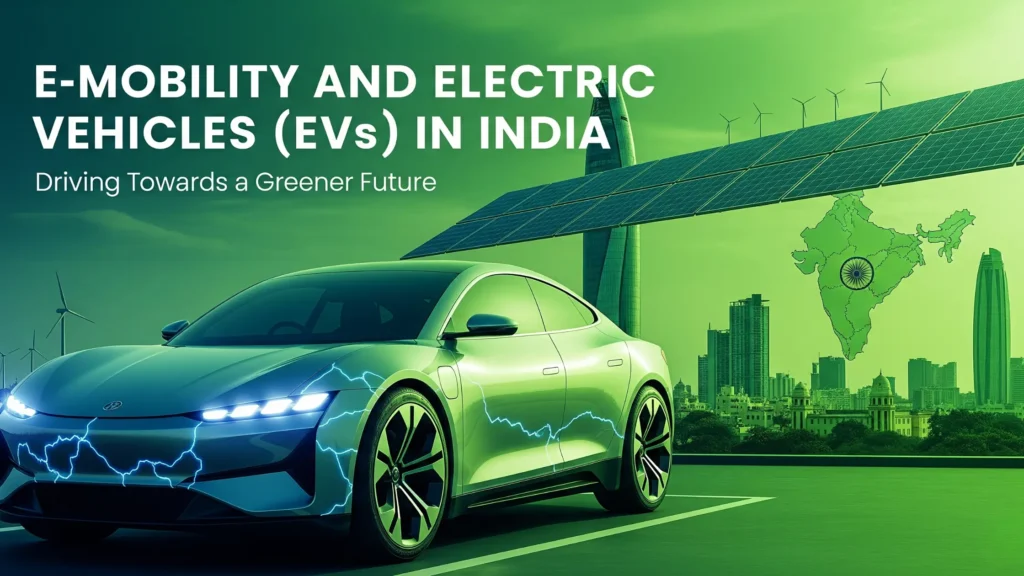E-Mobility and Electric Vehicles (EVs) in India: Steering Towards a Sustainable Future
India’s transportation landscape is undergoing a significant shift as electric mobility (e-mobility) moves from niche to mainstream. With government incentives, growing environmental awareness, and rapid technological advancements, electric vehicles (EVs) are no longer just futuristic concepts—they’re becoming an everyday reality for Indian consumers.
Why E-Mobility Matters for India
India faces two pressing challenges: air pollution and rising fuel costs. Cities like Delhi, Mumbai, and Bengaluru rank among the most polluted in the world, and the country’s dependency on imported oil strains the economy. E-mobility offers a sustainable solution by reducing emissions and lowering the cost per kilometer compared to petrol or diesel vehicles.
Moreover, the global push toward net-zero emissions aligns perfectly with India’s commitment to achieve net-zero carbon emissions by 2070. EV adoption plays a pivotal role in this mission.
The Current State of EV Adoption in India
Over the past few years, EV adoption has accelerated. While electric two-wheelers and three-wheelers currently dominate the market, four-wheeler EVs are also gaining traction. Models like the Tata Nexon EV, MG ZS EV, and Mahindra XUV400 have brought electric cars into the mainstream, offering competitive ranges and features at relatively affordable prices.
The two-wheeler segment, with brands like Ola Electric, Ather Energy, and TVS iQube, is leading the charge. Low running costs, easy charging options, and government subsidies have made e-scooters especially appealing for urban commuters.
Government Initiatives and Incentives
The Indian government has rolled out several initiatives to boost EV adoption:
- FAME II (Faster Adoption and Manufacturing of Electric Vehicles): Offers subsidies on EV purchases and supports the development of charging infrastructure.
- State-Level Policies: States like Delhi, Maharashtra, and Tamil Nadu provide additional incentives such as tax exemptions, purchase subsidies, and free registration.
- GST Reduction: The GST on EVs has been reduced to 5%, making them more affordable.
These policies aim to make EVs cost-competitive with their internal combustion counterparts.
Charging Infrastructure: The Road Ahead
One of the key challenges for EV adoption in India is charging infrastructure. While metro cities are seeing a rise in public charging stations, rural and semi-urban areas still lag behind. Companies like Tata Power, BPCL, and ChargeZone are working to establish nationwide networks, and initiatives like battery swapping stations for two- and three-wheelers are gaining momentum.
Home charging solutions are also becoming popular, especially for private car owners. Many EV manufacturers now include home chargers with vehicle purchases, reducing dependence on public infrastructure.
Challenges Facing E-Mobility in India
Despite the progress, several hurdles remain:
- High Initial Cost: Although running costs are low, EVs still have a higher upfront price.
- Battery Technology and Range Anxiety: Current battery technology limits range, and charging can take longer than refueling.
- Limited Model Options: While variety is increasing, the market still lacks options across all price segments.
Addressing these challenges will be key to accelerating adoption.
The Future of E-Mobility in India
India’s EV market is expected to grow at a CAGR of over 40% by 2030. As battery costs decline, range improves, and charging networks expand, EVs will become the default choice for many buyers.
Innovations such as solar-powered charging stations, smart charging grids, and vehicle-to-grid (V2G) technology could further transform the landscape. Additionally, local manufacturing under the Make in India initiative will not only reduce costs but also boost job creation in the green mobility sector.
Conclusion
E-mobility in India is more than just a trend—it’s a movement toward cleaner air, energy independence, and sustainable growth. While challenges remain, the combined efforts of the government, private sector, and consumers are steering India toward a greener, more efficient transportation future.
The wheels are in motion, and with the right policies and innovations, India could very well become a global leader in electric mobility.



